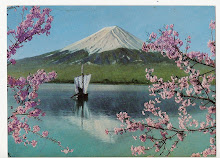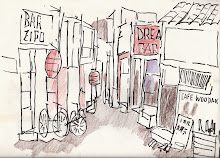Mid 1950s Tokyo. A horde of pedestrians crosses in front of a 6000-series Tokyo metropolitan streetcar.
The sign in the foreground says that this is A Avenue and 10th Street. The US military imposed a system of street names on the major thoroughfares in Tokyo after the end of World War Two. Lettered avenues radiated from the Imperial Palace clockwise. "A Avenue" ran south from the southeast corner of the Imperial palace, on Hibiya Boulevard (Hibiya Doori). The numbered streets were basically major roads essentially ringing the palace. 10th is Outer Moat Boulevard (Sotobori Doori). So this is the Nishi-shinbashi Crossing, just south of Hibiya Park. At the time the neighborhood - and the streetcar stop - was called Tamuramachi (田村町). We must be looking east, because the sun is hitting the face of the building on the right.
It pre-dates 1957, when Tokyo's streetcars were repainted yellow. The lines which ran on Hibiya Doori through this intersection were 1, 5, 35 and 37.
There's an outside chance that this streetcar is 6103 (see the trailing digit 3), which is now in Shinmei Toden Shako Park in Bunkyo Ward.
Here's a zoom on a part of the map published by the US military in 1948 with the street names.
And here's the neighborhood on an interactive 1956 map of Tokyo.
Found in an antique store's photo bins.
Text by Rob Ketcherside
_________________________________
This is a fond reminder of the era. I was here in the early 60s.
YOKOHAMA PICTURE SHOW

Shot with my Petri in Yokohama 1962
RICE FIELD IN JAPAN 1962

I took this with my PETRI in Kanagawa Prefecture
Friday, November 25, 2011
Streetcar in Tokyo near Shinbashi Station, circa 1955
Monday, November 21, 2011
TRAINS OF YOKOHAMA IN EARLY 60S
Scanned from a slide shot with my Petri 7. I have a lot of slides I need to scan before too much more time passes. I don't know how many years a slide will last, but this one was shot in 1961, so it's 50 years old and doesn't look too bad after a little editing with PICNIK.
There was still much reconstruction going on doing my tour of duty.
Now, after the terrible tragedy of the recent earthquake and tsunami, there will be more years of construction and sorrow
Friday, November 18, 2011
View of Fuji-san from Kamakura, Japan
THIS IS A MASTERPIECE. Since leaving Japan in 1963 after nearly three years, I have longed to return someday to see Mt. Fuji. If I cannot make it, this photograph is almost like seeing Fuji-San in person.
You have captured this scene in a manner that makes it appear as it might have been seen a century ago.
Your lighting, framing and attention to details has made this scene one of the best I have seen during the past 50 years. Thanks for sharing this memory.
__________________________________
My gratitude to Mikael Tilly for such a great photograph.
THE PEANUTS CLUB---PART OF MATCHBOX COLLECTION
Part of my matchbox collection of Japanese bars I frequented. The PEANUTS CLUB has some very special memories for me. It was there where I would meet a young Japanese girl I would remember for the rest of my life.
THE PEANUTS CLUB IN YOKOHAMA: 1961, 1962, 1963...four floors with an elevator of live music..(日本語ロック論争,
THE PEANUTS CLUB IN YOKOHAMA: 1961, 1962, 1963...four floors with an elevator of live music..(日本語ロック論争,, a photo by roberthuffstutter on Flickr.
THE PEANUTS CLUB IN YOKOHAMA: 1961, 1962, 1963...four floors with an elevator of live music..(日本語ロック論争,
Unless one really knew about the Peanuts Club, or heard the music playing all night and all day, one might walk by the somewhat austere fascade where the arrow pointed up. But really, one had only to be in the service or in their teens to know about the Peanut or Peanuts Club. It attracted the likes of my type, a young guy in the service, Japanese teenagers in their late teens and dependents in their late teens who lived at the Yokohama Housing for U.S.Service and Government employees. It was the coolest musical pub and coffee bar or pub in Yokohama.
WHO REMEMBERS THE WIEN COFFEE SHOP?
I told her I did not know where the Wein Coffee Shop was located. She wrote the address or directions on a piece of paper and told me to give it to taxi man. "He knows, I know," she said. "We meet at noon, okay?" I squeezed her hand and smiled. She returned my smile.
pond at sankeien
THIS PHOTOGRAPH BY MOLLY DES JARDIN is a marvelous capture of a special memory. Her photo seems to have captured the park exactly as I recall seeing it for my first time, in the autum of 1962.
Sankien Gardens is the first place my new friend and I went.
We had both discussed how we liked to sketch, thus we decided to meet at a nearby coffee and wine shop and proceed from there.
I told her I did not know where the Wein Coffee Shop was located. She wrote the address or directions on a piece of paper and told me to give it to taxi man. "He knows, I know," she said. "We meet at noon, okay?" I squeezed her hand and smiled. She returned my smile.
Did I believe she would really be there at noon? I hoped she would be. I was already in love with this young lady who still had on her blue Middy blouse. I escorted her down the stairs to a waiting taxi. We did not kiss good night. I waved as the taxi pulled out into the Yokohama traffic of the wee hours of the morning.
Wow, I thought, I might have finally found the young woman of my dreams. I returned up the stairs of the Peanut Club as a western band and singer were doing a Patsy Cline version of "I Fall to Pieces."
Sunday, November 6, 2011
Kyoto Gion
THIS IS A PHOTO THAT REMINDS ME OF THE EARLY 60S. THANKS TO jpellgen FOR SHARING THIS PHOTOGRAPH.
___________________________________
Gion, Kyoto... A very traditional area just beyond the Kamo-gawa which is undoubtedly the most famous place in Japan to see Geiko activity. The area surrounding Gion is home to Yasaka Shrine, as well as Hanami-koji, a street lined with old ochaya (tea houses) and restaurants.
__________________________________
Take a tour of JPELLGEN'S photos by following the highlighted text.
Japan : Beautiful Samurai
Japan : Beautiful Samurai
芸妓 君香さん
The geiko (geisha) Kimika plays the 12th century samurai warrior Tomoe Gozen in the Jidai Matsuri, one of the three big festivals of Kyoto, Japan.
Over 2,000 people, including many geiko (geisha) and maiko (apprentice geisha), wore costumes representing various eras of Kyoto's 1,200-year history as they paraded through the city.
Kyoto was the capital of Japan from 794 until 1868. It is now the seventh largest city in Japan.
_________________________________
Thanks to Michael Chandler for a beautiful photograph. You are able to go to his Flickr Photostream by following the highlighted text and/or title.
Thursday, November 3, 2011
YAMATO TRAIN STATION 1963 JAPAN 日本
YAMATO TRAIN STATION 1963 JAPAN 日本
.This was done at the Yamato Train Station in Yamato, Japan in 1962. While stationed in a Naval Air Squadron based at NAS Atsugi, Japan from 1961 through the eve of 1964, I sketched many scenes of local towns, bars and city scenes. Many were given to bar owners and friends.
When I purchased a new Petri, my first 35mm camera, I enjoyed shooting photos. Looking back almost 50 years, I must admit that my tour in Japan was one of the most exciting times of my youth.
THE BEGINNING OF A SUPER ECONOMY IN JAPAN
From the ruins of a devastated nation to one of the world's super economic powers. There are many nations that might well learn much about Japan. It is not Japan's natural resources that has made it a success, it is Japan's character.
Unless a nation has character, it will remain poor and hopeless. There are many factors here that some nations will never understand because they have decided to hate free enterprise and especially American democracy.
I have more admiration for Japan than any other nation on earth, except my own USA. Having lived in Japan for more than two years in the early 60s, I recall the energy that was exhibited by the people rebuilding a nation.
I frequently traveled from Atsugi to Yokohama and Tokyo by train and watched the progress. I saw piles of glass of different colors almost everywhere. I asked my close friend what it was and what it all meant. She told me that it was "saving glass for making new glass." Now, looking back, I realize it was recycling.
When walking around Yoiohama as I so frequently did, I saw workers building one project after another. There was always the sounds one hears around men involved in construction. On more than one occasion, I was offered to share a bit of lunch with workers who did not speak English but extended friendship in the strange fare of fish and rice in various forms. At the time, I thought it a nice thing to do; in retrospect, I realize it was much more than something simply nice or polite. Yes, I harbor many deep and wonderful emotions when I think of Japan.
By Robert L. Huffstutter
I now have a public group called BLOGABOUTJAPAN which appears in the Flick Photostream. It is open to those who would enjoy posting positive photos, art and information about Japan.











